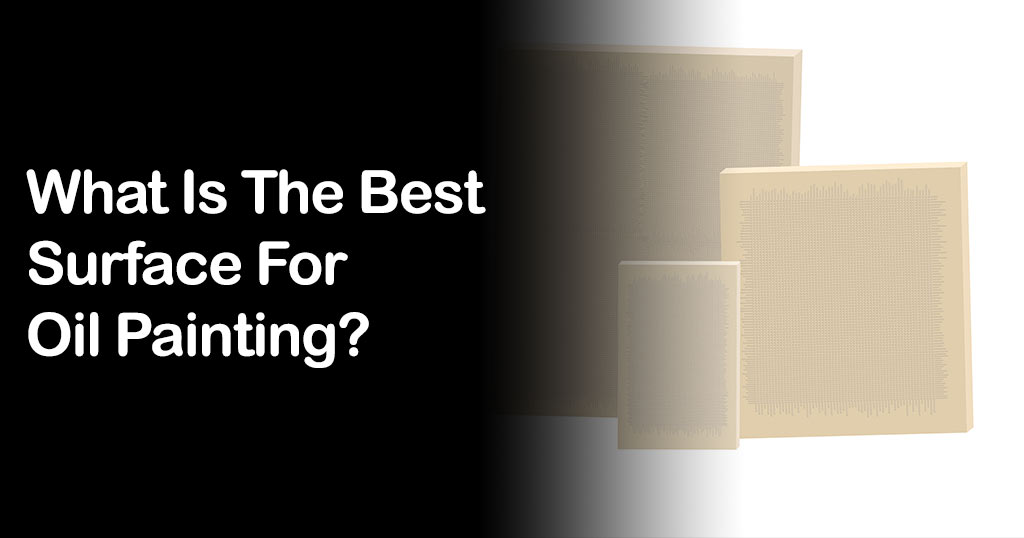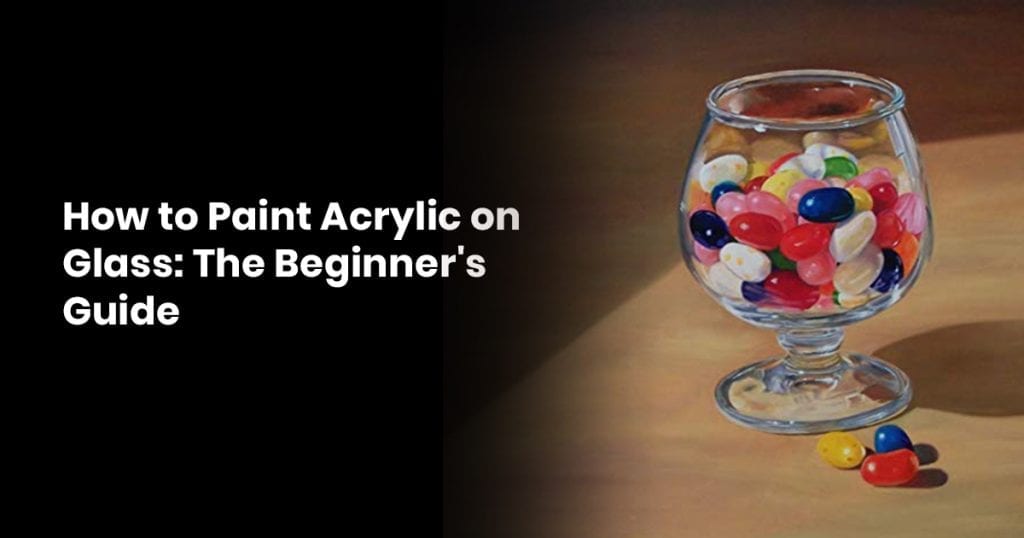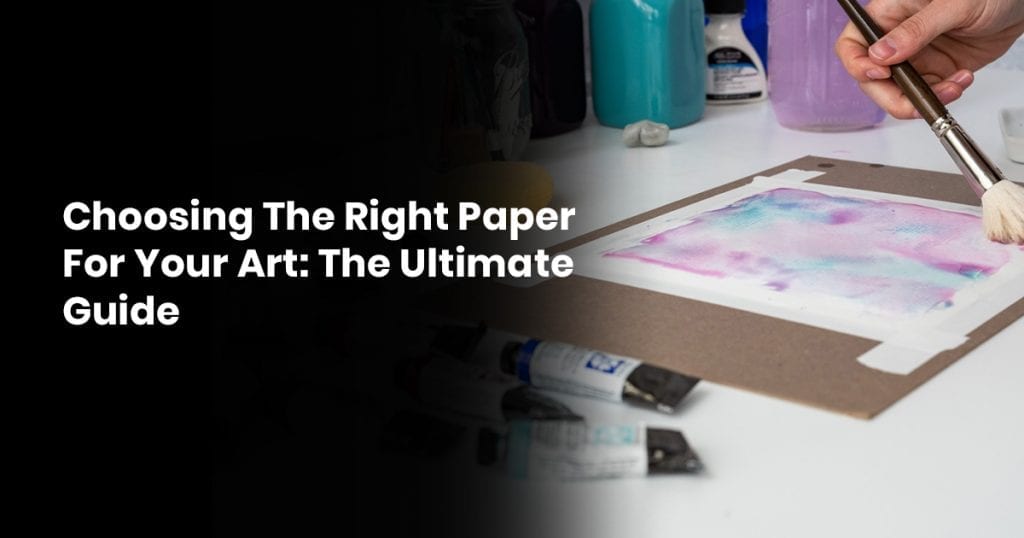Oil painting is the medium that has been used by most famous artists through the years, as well as to create some of the greatest works of art known to us. The reason it is such a well-loved form of painting is because of its rich colors as well as providing artists with the ability to capture the smallest details. For this reason, many artists, both seasoned veterans, and voices, turn to oil paint when trying to create a beautiful work of art.
It is important to keep in mind that choosing the correct surface to paint on is just as important as choosing oil paint in the first place. This is because there are some surfaces work really well with the medium, whereas others can compromise the effects of the oil. Discussed in this article are some of the best and worst common surfaces considered for oil-painting.
Contents
Canvas
We can easily say that canvas is the best surface for oil painting with little controversy. It has been chosen for hundreds of years by some of the best painters in history, due to it being able to provide the best support for oil paint. Some of the most popular paintings such as Vincent Van Gogh’s Starry Night, or Leonardo Da Vinci’s Mona Lisa are all painted on a canvas. The most common canvases used by artists are typically made of either cotton or linen.
Linen canvas is often more difficult to work on than its counterpart. This is often due to it having to be stretched and primed before use, which is not an easy process, might I add. It also takes much longer to prepare. Moreover, this can be a drag for artists who are raring to get their ideas onto the surface. Annoyingly, it is also more expensive. This can often prove to be a serious issue, especially for the artist on a budget.
In spite of all the negatives associated with them, linen canvases are considered to be the crème de la crème in terms of services to paint on with oil paint. They deliver the best results, and for this reason, are often chosen by avid painters. The artworks painted onto these canvases tend to last for generations, whereas paintings on other variations tend to fade with time.
Of course, this does not take anything away from cotton canvases. These are often much easier to work with, making them the preferred choice for novices or newcomers. They are also available at much more affordable prices than those of the linen variation. Due to this, they are a common favorite of artists who do not have tons of money to spend on canvases, as well as hobbyists.
The primary difference between linen and cotton canvases is the overall finish that they offer to painters. They make a massive difference to an art connoisseur, although the difference is not telling enough to deter you from using the cotton canvas if you are just painting for fun or working to create personal pieces.
Linen canvases tend to offer the artist a much more visible and luminous finish, whereas when cotton canvases are used, the painter is offered a semi-matte finish due to the cotton absorbing some of the paint. Artists can use this to their advantage depending on the type of artwork they are creating, and the finish they feel is most appropriate for it.
It is important to note that should the cotton canvas be primed before its use, the absorbing effect that it has is drastically reduced.
There are different varieties of canvas available for you to choose from, all of which deliver a completely different effect and texture. This can make an impressionable difference to an artwork if used correctly. Let’s take a look at some of them to better understand their effects.
Stretched Canvas
Stretched canvas is one of the most famous variations and gets its name from the process through which it is created. It is made through a process of stretching and stapling the canvas onto wood stretchers. The process allows the fabric to obtain a level of elasticity, making it much easier, and more flexible to work on. A stretched canvas is generally preferred for paintings that are created for display purposes.
Canvas Panel
Canvas panels are generally preferred by artists who are still practicing or complete beginners. This is because they are available at a much more affordable price in comparison to other variants. Since they are inexpensive, artists can try many new things, and test ideas on them without having to worry about having to replace the surface at a crippling price.
The structure of this type of canvas is also very different from others. They are created by gluing or otherwise attaching canvas onto a board of compressed paper or sometimes even cardboard. The texture of canvas panels is very similar to the texture afforded to artists by stretched canvas, although do offer a slightly tighter feel to allow for better and lighter brush strokes.
Canvas Pad
If you are looking for another good option to practice on, the canvas pad is one to consider. Should you still be in the process of mastering oil painting, this option is probably the most convenient for you.
The canvas pads contain multiple canvas sheets that can easily be torn off the pad. This allows a lot of space for the error of the artist, making it a perfect option for those still getting the hang of oil paint. The pads come in a variety of fixed dimensions, making it easy to find a size that you intend to practice with.
Canvas pads are also extremely versatile and can be used for other arts and crafts. This increases the appeal they offer. Therefore, if you are an artist who does not only use oil paint, and enjoys experimenting with different mediums, then this is definitely something for you to consider.
It is important to note that the overall structure of the sheets in a canvas pad is not as strong as a canvas that has been attached to a fixed support. Canvas pads are also not designed for long-term paintings and are preferred for temporary paintings. For this reason, if you intend on displaying or selling the painting, you should consider other surfaces.
Canvas Roll
The last canvas surface discussed here is the canvas roll. Similar to stretched canvas, it is one of the most preferred surfaces used by oil painters. Canvas rolls allow the artist to have any size they desire. This is extremely handy, and many painters take advantage of it. The work surface is essentially limitless, affording artists the space to tell stories through their artwork.
Canvas rolls work particularly well for artists looking to convey bits of a continuous painting through their artwork. They often paint a large scene on a canvas roll and then proceed to cut this piece into smaller artworks. Doing this creates the illusion of a story being told within the painting.
Should you choose to purchase large quantities of this canvas, it becomes relatively inexpensive and affordable. Due to this, if you are an artist who loves to paint constantly, canvas rolls are definitely an option that you should consider if you have not already done so.
Paper
Paper is another surface that works really well with oil paint. The results depend heavily on the consistency of paint, the amount of paint, and also the thickness of the paper. If all the right amounts are used, great results are, usually, produced by artists.
Many artists enjoy using paper for their artworks due to it being much more affordable than canvas, as well as it providing some extra grip on the surface. The paper also offers really good support for oil paintings, making it a really popular choice. You should be aware that some papers are of higher quality than others, and as a result, offer better results when used.
When looking for the right kind of paper for your oil paintings, there are a number of considerations to make before making the decision. These factors all affect the quality of the painting. Listed below are the factors to consider before purchasing paper as the surface for your oil painting:
- Weight: Oil paint is heavy by nature, what this means is that if you intend on using paper as a surface, you also need heavy paper to support the paint. Heavier paper does not buckle as easily as a lighter variant when it comes into contact with a liquid. This ability allows it to dry much more beautifully. When selecting paper for oil painting, it is recommended that you use paper with a thickness of 300 or higher. You can identify the thickness of the paper by looking at the label on its packaging.
- Acid Level: The acid level of a piece of paper can have a major impact on the oil paint used on it. If you want the painting to last for a long time as well as age successfully, then you have to use acid-free paper. Papers that consist of an acid content usually affect the quality of the painting after it has been completed. This is due to the acid having an effect on the composition of the oil paint. Acid-free papers, on the other hand, prevent the painting from experiencing any discoloration as well as keeping it both fresh and vibrant for years. Papers of high quality are generally marked as either acid-free or as being pH neutral.
- Durability: Although it is important that the paper is acid-free to promote the longevity of your oil painting, it is also important that the paper is able to handle rough techniques such as erasing without tearing or ripping. Strong papers are typically made entirely of either cotton or linen fiber. When choosing paper, it is important that you steer clear of those made from wood. This is because they tend not to last as long as other varieties. Also, papers made from wood or wood fiber generally contain acids that can negatively affect any artwork you create.
- Primed: Papers that have been primed are generally the best, and also offer the most support for oil paintings. Some painters prefer drawing paper as it has already been primed, making it much sturdier than paper that has not undergone the process. However, you are able to prime paper yourself. Should you wish to do so, it is advised that you apply the first coat of a primer such as gesso to ensure that the priming process is successful.
Wood
Unlike some of the previously mentioned surfaces, wood provides both a smooth and robust surface simultaneously. It is also possible to get wood with different textures should you wish to. When using wood, you do not have to concern yourself with the durability of the surface. It is possible for wood to decay; however, that is dependent on the type of wood, its preparation, and is also highly unlikely.
There are a number of wood variations, all of which are great for oil painting. Some of these wood types are:
- Walnut
- Basswood
- Birch
- Maple Wood
- Baltic Birch
Wood has the ability to last for a number of years; however, the climate in which you live can have some effects on even the best quality wood. If you live in a humid or misty environment, this does not bode well for wood. This type of climate can cause the wood to rot and decay in ways that it would not in a warmer, dry climate. Should you live in an area with such a climate and still wish to use wood, you have to apply coats of wood protection, followed by the application of primer before you begin to paint on the surface.
In a normal climate, the only preparation required for wood is priming it before you begin painting. When priming wood, it is recommended that you use gesso as it is a primer that is preferred by artists all over the world.
Choosing the right wood surface is entirely dependent on the nature and style that you adopt while painting. It shouldn’t be too difficult of a choice as all the types of wood mentioned above are great for oil painting, and the one you choose boils down to personal preference at the end of the day.
MDF
MDF is otherwise referred to as medium density fiberboard and is a modified type of wood that consists of both resin and wax. This material is made by grinding wood fibers and then proceeding to mix them with a solution of resin, wax, and adhesive under extreme pressure. The process makes the wood much heavier and even stronger than other boards used for painting purposes.
This type of wood is perfect for any permanent painting due to it being so durable and having great longevity. It is also available at a much more affordable price than hardwood and plywood boards, making it a no-brainer for artists looking for a great surface for a permanent painting on a budget.
Before you begin painting on MDF, you are required to prepare it for the oil paint. In order to prepare it, you have to:
- Sand the board to clear any obstacles.
- Polish and clean the surface.
- Coat the MDF with a good primer.
When you begin sanding and smoothing the surface of the MDF, it is recommended that you use sandpaper with a grit of 360 or higher. This speeds up the sanding process without compromising the structure of the surface.
Once you have completed the sanding process, you should use a damp cloth to clean the surface and ensure that there are no specks of sawdust left behind. After cleaning it, you can begin polishing it with a dry cloth. Whether or not you choose to apply a coat of conservator is entirely up to you.
The last step in the preparation involves you priming the surface for painting. By doing so, you ensure that the paint remains in place, and also enhance the texture and quality of the oil painting.
Should you wish to be extremely pedantic, you can choose to complete each of these processes twice for the best painting results. This can be timely; however, the results of doing so are often worth it.
Glass
This is one surface that is very different from any of the others mentioned so far. Unlike any of the other surfaces that have already been mentioned, glass is unable to absorb liquid paints in any way. The surface is entirely smooth and oilproof. It is important to note that oil and acrylic paints are the only ones that work well on glass, whereas others are not recommended. Oil paints have the ability to stick to glass really well if the surface is prepared properly, making it a favored choice of surface by many artists.
When using oil paint on glass, using thin layers is recommended, as thick layers of paint usually crack and peel off with time, regardless of the preparation. The thin layers of oil paint also have a much better appearance as they do not completely hide the glass surface. This gives the painting a unique look and feel.
Although this all sounds good, it is important that you prepare the surface before you begin painting. In order to prepare the surface, you have to:
- Clean the surface: It is entirely possible that oil paint can crack when applied to glass, and for this reason, the cleaning process is essential. You can use normal detergents to clean the glass; however, it is recommended that you use a cleaning solution such as isopropyl alcohol. This solution completely removes any stubborn stains on the glass.
- Create a texture: After cleaning the glass, you have to create the tooth for painting. After the glass has dried from the cleaning process, you should sand the surface of the glass to get your desired texture. This prevents the paint from peeling off the surface in the future, thus preserving the artwork’s longevity.
- Priming the surface: The final step in the process is the priming of the glass. You should consider using gesso for this process. We previously mentioned that this is one of the most preferred primers by artists. Primers are normally white in their color. Some artists may like the idea of using a white primer on a glass surface; however, there is another option available to you. You can make use of clear gesso. We suggest doing so, as the clear gesso maintains the appearance of the glass and works very similarly to normal white gesso.
After following these preparation steps, your glass is ready to be painted on. You can get to work, creating the masterpiece you have envisioned without having to worry about your oil paint cracking or peeling off the surface.
Conclusion
With so many surfaces to choose from when oil painting, it is understandable why there is some confusion when choosing which surface is the best for you. After reading this article, you should have a better idea of which surface is best for you. The surface that you choose should complement your style of painting as well as your needs. You now know that the surface you choose affects the longevity and quality of your painting. Therefore, keeping this in mind, as well as the budget you have available, you can make the best possible choice.




